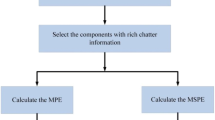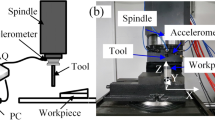Abstract
On-line detection of chatter in the cutting process can identify the chatter in time or before the chatter happens, so the initiative to change the cutting parameters can be taken to avoid chatter and improve the surface quality. At present, time-frequency analysis technology is performed to extract the time-frequency features of chatter by scholars. With respect to the modal aliasing problem in the process of empirical mode decomposition (EMD), the chatter identification method of combining EMD and wavelet packets decomposition (WPD) is proposed to eliminate the influence of modal aliasing. To fully extract the main features of signal, the intrinsic mode functions (IMFs) changing consistent with power spectrum or amplitude-frequency are selected for signal reconstruction. Then, WPD is used in the reconstructed signal. The two times reconstruction of signal is based on wavelet packet node with the maximum energy. The distribution of frequency and energy in the time domain is presented by Hilbert Huang Transform (HHT) spectrum, and the mean value and standard deviation of the HHT spectrum are extracted as the feature vectors. The chatter features can be extracted from the original simulation signal by this method. Three groups of experiments with different cutting depth which are on behalf of the three cutting conditions (stable cutting, slight chatter, and severe chatter) were carried out. More cutting tests were carried out under the same cutting condition. Experimental results show that this method can be used to effectively identify the chatter features in milling process.
Similar content being viewed by others
References
Compeán FI, Olvera D, Campa FJ, Lacalle LNLD, Elías-Zúñiga A, Rodríguez CA (2012) Characterization and stability analysis of a multivariable milling tool by the enhanced multistage homotopy perturbation method. International Journal of Machine Tools & Manufacture 57:27–33
Urbikain G, Fernández A, Lacalle LD (2013) Stability lobes for general turning operations with slender tools in the tangential direction. International Journal of Machine Tools & Manufacture 67:35–44
Urbikain G, Campa FJ, Zulaika JJ, Lacalle LNLD, Alonso MA, Collado V (2015) Preventing chatter vibrations in heavy-duty turning operations in large horizontal lathes. Journal of Sound & Vibration 340:317–330
Wan M, Ma YC, Zhang WH, Yang Y (2015) Study on the construction mechanism of stability lobes in milling process with multiple modes. Int J Adv Manuf Technol 79:1–15
Yue C, Liu X, Liang SY (2016) A model for predicting chatter stability considering contact characteristic between milling cutter and workpiece. Int J Adv Manuf Technol 3:1–10
Yang Y, Zhang WH, Ma YC, Wan M (2016) Chatter prediction for the peripheral milling of thin-walled workpieces with curved surfaces. International Journal of Machine Tools & Manufacture 109:36–48
Wan M, Ma YC, Feng J, Zhang WH (2016) Study of static and dynamic ploughing mechanisms by establishing generalized model with static milling forces. Int J Mech Sci 114:120–131
Wan M, Wang YT, Zhang WH, Yang Y, Dang JW (2011) Prediction of chatter stability for multiple-delay milling system under different cutting force models. International Journal of Machine Tools & Manufacture 51:281–295
Wan M, Altintas Y (2014) Mechanics and dynamics of thread milling process. International Journal of Machine Tools & Manufacture 87:16–26
Bustillo A, Lacalle LNLD, Fernández-Valdivielso A, Santos P (2016) Data-mining modeling for the prediction of wear on forming-taps in the threading of steel components. Journal of Computational Design & Engineering 3:337–348
Álvar AG, Fernández VA, Bustillo A, Lacalle LNLD (2016) Using artificial neural networks for the prediction of dimensional error on inclined surfaces manufactured by ball-end milling. Int J Adv Manuf Technol 83:847–859
Miran B, Miha K (2003) Integrated genetic programming and genetic algorithm approach to predict surface roughness. Mater Manuf Processes, 18:475–491
Yildiz AR (2013) Cuckoo search algorithm for the selection of optimal machining parameters in milling operations. Int J Adv Manuf Technol 64:55–61
Escamilla-Salazar IG, Torres-Treviño LM, González-Ortíz B, Zambrano PC (2012) Machining optimization using swarm intelligence in titanium (6al 4v) alloy. Int J Adv Manuf Technol 67:535–544
Yamada Y, Kakinuma Y (2016) Sensorless cutting force estimation for full-closed controlled ball-screw-driven stage. Int J Adv Manuf Technol. doi:10.1007/s00170-016-8710-5
Khasawneh FA, Munch E (2016) Chatter detection in turning using persistent homology. Mechanical Systems & Signal Processing 70:527–541
Matthias W, Özşahin O, Altintas Y, Denkena B (2016) Receptance coupling based algorithm for the identification of contact parameters at holder-tool interface. Cirp Journal of Manufacturing Science & Technology 13:37–45
Siddhpura M, Paurobally R (2012) A review of chatter vibration research in turning. Int J Mach Tools Manuf 6:27–47
Urbański T, Kossakowska J, Jemielniak K (2010) Application of wavelet transform of acoustic emission and cutting force signals for tool condition monitoring in rough turning of Inconel 625. Proc Inst Mech Eng B J Eng Manuf 1:1–7
Litak G, Kecik K, Rusinek R (2013) Cutting force response in milling of Inconel: Analysis by wavelet and Hilbert-Huang transforms. Latin American Journal of Solids and Structures 10:133–140
Karam S, Teti R (2013) Wavelet transform features extraction for chip form recognition during carbon steel turning. Procedia CIRP 12:97–102
Meignen S, Oberlin T, Depalle P, Mclaughlin S (2016) Adaptive multimode signal reconstruction from time-frequency representations. Philosophical Transactions of the Royal Society A Mathematical Physical & Engineering Sciences 374:2065
Yao Z, Mei D, Chen Z (2010) On-line chatter detection and identification based on wavelet and support vector machine. J Mater Process Technol 210:713–719
Peng C, Wang L, Liao TW (2015) A new method for the prediction of chatter stability lobes based on dynamic cutting force simulation model and support vector machine. Journal of Sound & Vibration 354:118–131
Fang N, Pai PS, Mosquea S (2010) Effect of tool edge wear on the cutting forces and vibrations in high-speed finish machining of Inconel 718: an experimental study and wavelet transform analysis. Int J Adv Manuf Technol 52:65–77
Huang P, Li J, Sun J, Zhou J (2013) Vibration analysis in milling titanium alloy based on signal processing of cutting force. Int J Adv Manuf Technol 64:613–621
Wei CC, Liu MK, Huang GH (2016) Chatter identification of face milling operation via time-frequency and fourier analysis. International Journal of Automation and Smart Technology 6:25–36
Zhang Z, Li H, Meng G, Tu X, Cheng C (2016) Chatter detection in milling process based on the energy entropy of VMD and WPD. International Journal of Machine Tools & Manufacture 108:106–112
Rafal R, Pawel L, Krzysztof K, Bogdan K, Jerzy W (2015) Chatter identification methods on the basis of time series measured during titanium superalloy milling. Int J Mech Sci 99:196–207
Cao HR, Lei Y, He Z (2013) Chatter identification in end milling process using wavelet packets and Hilbert-Huang transform. Int J Mach Tools Manuf 69:11–19
Cao HR, Zhou K, Chen X (2015) Chatter identification in end milling process based on EEMD and nonlinear dimensionless indicators. Int J Mach Tools Manuf 92:52–59
Fu Y, Zhang Y, Zhou H, Li D, Liu H, Qiao H (2016) Timely online chatter detection in end milling process. Mech Syst Signal Process 75:668–688
Yang YF, Wu YF (2013) Applications of empirical mode decomposition in vibration analysis. National Defence Industry Press, Beijing
Cao HR, Yue YT, Chen XF, Zhang XW (2016) Chatter detection in milling process based on synchrosqueezing transform of sound signals. Int J Adv Manuf Technol 1:1–9
Author information
Authors and Affiliations
Corresponding author
Rights and permissions
About this article
Cite this article
Liu, C., Zhu, L. & Ni, C. The chatter identification in end milling based on combining EMD and WPD. Int J Adv Manuf Technol 91, 3339–3348 (2017). https://doi.org/10.1007/s00170-017-0024-8
Received:
Accepted:
Published:
Issue Date:
DOI: https://doi.org/10.1007/s00170-017-0024-8




